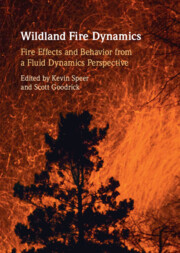Book contents
- Wildland Fire Dynamics
- Wildland Fire Dynamics
- Copyright page
- Contents
- Contributors
- 1 Wildland Fire Combustion Dynamics
- 2 The Structure of Line Fires at Flame Scale
- 3 Energy Transport and Measurements in Wildland and Prescribed Fires
- 4 Fire Line Geometry and Pyroconvective Dynamics
- 5 Firebrands
- 6 Re-envisioning Fire and Vegetation Feedbacks
- 7 Wind and Canopies
- 8 Coupled Fire–Atmosphere Model Evaluation and Challenges
- Index
- References
8 - Coupled Fire–Atmosphere Model Evaluation and Challenges
Published online by Cambridge University Press: 16 June 2022
- Wildland Fire Dynamics
- Wildland Fire Dynamics
- Copyright page
- Contents
- Contributors
- 1 Wildland Fire Combustion Dynamics
- 2 The Structure of Line Fires at Flame Scale
- 3 Energy Transport and Measurements in Wildland and Prescribed Fires
- 4 Fire Line Geometry and Pyroconvective Dynamics
- 5 Firebrands
- 6 Re-envisioning Fire and Vegetation Feedbacks
- 7 Wind and Canopies
- 8 Coupled Fire–Atmosphere Model Evaluation and Challenges
- Index
- References
Summary
Coupled fire–atmosphere feedback is essential for modeling wildland fire spread, especially extreme fire phenomena. In this chapter, the suite of current and emerging tools capable of modeling this complexity is examined; these tools now dominate fundamental wildland fire research and are starting to be applied to fire operations, training, and planning. Some of the barriers to progress and challenges to validating these tools highlighted in this chapter suggest more emphasis on three areas: a scale-dependent and purposeful approach to comparing model results with appropriate observations, recognizing the limitations of each; the quantification of the errors and under-specifications in fuel properties and the impact of each; and assessing large-scale simulations and directing observations to address priority research gaps, from a position informed by the vast catalog of atmospheric scientific research.
Information
- Type
- Chapter
- Information
- Wildland Fire DynamicsFire Effects and Behavior from a Fluid Dynamics Perspective, pp. 209 - 249Publisher: Cambridge University PressPrint publication year: 2022
References
Accessibility standard: Unknown
Why this information is here
This section outlines the accessibility features of this content - including support for screen readers, full keyboard navigation and high-contrast display options. This may not be relevant for you.Accessibility Information
- 1
- Cited by
